|
|
 |
Fiche d'espèce de Copépode |
|
|
Calanoida ( Ordre ) |
|
|
|
Clausocalanoidea ( Superfamille ) |
|
|
|
Aetideidae ( Famille ) |
|
|
|
Bradyetes ( Genre ) |
|
|
| |
Bradyetes inermis Farran, 1905 (F,M) | |
| | | | | | | Ref.: | | | Farran, 1905 (p.32, Descr.F, figs.F); Rose, 1933 a (p.92, figs.F); Sewell, 1948 (p.499); Vervoort, 1952 b (n°43, p.3, figs.F); Bradford, 1969 b (p.502); Grice, 1972 a (p.224, figs.F,M, Rem.M); Markhaseva, 1996 (p.64, figs.F,M); Vives & Shmeleva, 2007 (p.549, figs.F,M, Rem.); Markhaseva & Schulz, 2006 a (p.143, 150, figs.F, Rem.) | 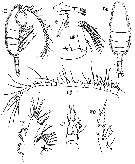 issued from : G.P. Farran in Ann. Rep. Fish. Brch., Ireland, 1902-1903, II, App. 2, 1905. [Plate III, Figs.13-20]. Female (from W Ireland): 13-14, habitus (lateral and dorsal, respectively); 15, A1; 16, A2; 17, Mx1; 18, Mxp; 19, P1; 20, P2.
|
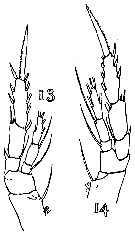 issued from : G.P. Farran in Ann. Rep. Fish. Brch., Ireland, 1902-1903, II, App. 2, 1905. [Plate IV, Figs.13-14]. Female: 13, P3; 14, P4.
|
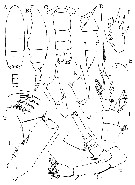 issued from : E.L. Markhaseva & K. Schulz in Invert. Zool., 2006, 3 (2). [p.145, Fig.5]. With doubt. As Bradyetes cf. inermis. Female (from S Atlantic): A-B, habitus (dorsal and lateral, respectively); C, posterior prosome and urosome (dorsal and left lateral view, respectively); E, rostrum (left lateral view); F, A2; G, Mx1 (praecoxal arthrite); H, Mxp (syncoxa); I, P1; J, P3 (exopodal segments 1 and 2); K, P4 (exopodal segments 1 and 2); L, P2. Scales: A-B 0.5 mm; remaining figures 0.1 mm. Above sea-bed at depths 4725-4469 m (41°08'S, 9°56'E) and 2889, 3005 m (60°38'S, 53°57'W and 58°16'S, 24°54'W, respectively). Nota : Mx1 : praecoxal endite with 9 long and 2 small setae (length of smaller setae varies, sometimes 1 much smaller) ; coxal endite with 4 setae (1 longer and thicker than others) ; endopod with 12 setae ; exopod with 11 setae ; coxal epipodite with 9 setae. Mx2 : praecoxal and proximal coxal endites with 3 setae each ; proximal basal endite with 3 setae (1 thicker and more sclerotized, spine-like) ; distal basal endite plus ramus with 8 setae (6 long and 2 small) ; praecoxal and coxal endites with short surface spinules. Mxp : Coxal endite with 3 setae and small sensory appendage.
|
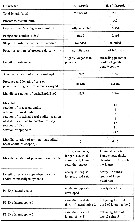 issued from : E.L. Markhaseva & K. Schulz in Invert. Zool., 2006, 3 (2). [p.150, Table I]. Female: Selected character for B. inermis Farran and the form of Markhaseva & Schulz as B. cf. inermis.
Nota: Up to now descriptions of B. inermis are not very detailed and suffer from some inconsistencies, i.e. the lateral lobe of P1 endopod is figured as being well-developed by Grice (1972), but poorly in drawings by Farran (1905).
|
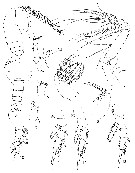 issued from : G.D. Grice in Crustaceana, 1972, 23 (3). [p.222, Figs.2-13]. Female (from off S Cap Cod): 2, habitus (lateral right side); 3, posterior end of prosome and urosome (dorsal); 4, A2; 5, Md (mandibular palp); 6, Md (cutting edge); 7, Mx2; 8, idem (other side); 9, Mxp; 10, P1; 11, P2; 12, P3; 13, P4.
|
 issued from : G.D. Grice in Crustaceana, 1972, 23 (3). [p.225, Figs.14-22]. Male (from off S Cap Cod): 14, habitus (dorsal); 15, A1; 16, Md; 17, Mx1: 18, Mx2; 19, Mxp; 20, P5; 21, idem (other side); 22, distal end of exopod of left P5. Nota: A1 with numerous setae and long aesthetasks proximally. Mouth appendages greatly reduced, no mandible blade. P5 biramous, endopods consist of one segment with the left one being more than twice the length of the right one.
| | | | | Ref. compl.: | | | Pearson, 1906 (p.12); Grice & Hulsemann, 1965 (p.223); Vives, 1982 (p.291); Markhaseva, 1998 (p.250, Fig.4); Holmes, 2001 (p.45); Bradford-Grieve, 2004 (p.283) | | | | NZ: | 3 + 3 douteuses | | |
|
Carte de distribution de Bradyetes inermis par zones géographiques
|
| | | | | | | Loc: | | | Morocco-Mauritania, off Madeira, off S Cape Cod, off S & W Ireland, S Atlant., Antarct. (E South Shetland Is.) | | | | N: | 8 | | | | Lg.: | | | (58) F: 2,57; (213) F: 3,2-3; M: 2,52-2,44; (968) F: 2,95; {F: 2,57-3,20; M: 2,44-2,52} | | | | Rem.: | épi-méso & bathypélagique; ? hyperbenthique.
Pour Markhaseva et Schulz (2006 a), une redescription de cette espèce dans la localité type de l'atlantique nord est nécessaire pour confirmer sa distribution géographique, un doute subsistant sur l'identité des formes citées en atlantique nord et sud.
Voir aussi les remarques en anglais | | | Dernière mise à jour : 08/05/2016 | |
|
|
 Toute utilisation de ce site pour une publication sera mentionnée avec la référence suivante : Toute utilisation de ce site pour une publication sera mentionnée avec la référence suivante :
Razouls C., Desreumaux N., Kouwenberg J. et de Bovée F., 2005-2025. - Biodiversité des Copépodes planctoniques marins (morphologie, répartition géographique et données biologiques). Sorbonne Université, CNRS. Disponible sur http://copepodes.obs-banyuls.fr [Accédé le 27 août 2025] © copyright 2005-2025 Sorbonne Université, CNRS
|
|
 |
 |









